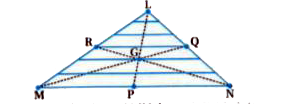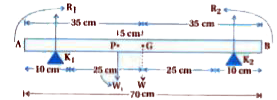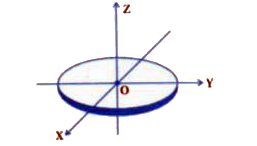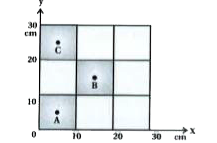SECTION-B NUMERICALS FROM TEXTUAL EXERCISE from KUMAR PRAKASHAN KENDRA PHYSICS (GUJRATI ENGLISH) SYSTEMS OF PARTICLES AND ROTATIONAL MOTION for Class 11
| Class 11 | PHYSICS |
| Chapter | SYSTEMS OF PARTICLES AND ROTATIONAL MOTION |
| KUMAR PRAKASHAN KENDRA PHYSICS (GUJRATI ENGLISH) | SECTION-B NUMERICALS FROM TEXTUAL EXERCISE |
| Medium | English |
| Academic Year | 2023-2024 |
Question 15
A cord of negligible mass is wound round the rim of a fly wheel of mass 20 kg and radius 20 cm. A steady pull of 25 N is applied on the cord as shown in Fig. 7.35. The flywheel is mounted on a horizontal axle with frictionless bearings.
(a) Compute the angular acceleration of the wheel.
(b) Find the work done by the pull, when 2m of the cord is unwound.
(c) Find also the kinetic energy of the wheel at this point. Assume that the wheel starts from rest.
(d) Compare answers to parts (b) and (c).View SolutionQuestion 28
A cord of negligible mass is wound round the rim of a fly wheel of mass 20 kg and radius 20 cm. A steady pull of 25 N is applied on the cord as shown in Fig. 7.35. The flywheel is mounted on a horizontal axle with frictionless bearings.
(a) Compute the angular acceleration of the wheel.
(b) Find the work done by the pull, when 2m of the cord is unwound.
(c) Find also the kinetic energy of the wheel at this point. Assume that the wheel starts from rest.
(d) Compare answers to parts (b) and (c).View SolutionQuestion 31
In the HCl molecule, the separation between the nuclei of the two atoms is about 1.27Å(1Å=10−10m). Find the approximate location of the CM of the molecule, given that a chlorine atom is about 35.5 times as massive as a hydrogen atom and nearly all the mass of an atom is concentrated in its nucleus. View SolutionQuestion 35
Find the components along the x, y, z axes of the angular momentum l of a particle, whose position vector is r with components x, y, z and momentum is p with components px,pyandpz. Show that if the particle moves only in the x-y plane the angular momentum has only a z-component. View SolutionQuestion 37
A non-uniform bar of weight W is suspended at rest by two strings of negligible weight as shown in figure. The angles made by the strings with the vertical are 36.9∘and53.1∘ respectively. The bar is 2 m long. Calculate the distance d of the centre of gravity of the bar from its left end.
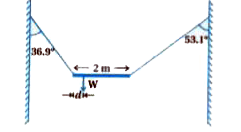 View Solution
View SolutionQuestion 39
(a) Find the moment of inertia of a sphere about a tangent to the sphere, given the moment of inertia of the sphere about any of its diameters to be 2MR25, where M is the mass of the sphere and R is the radius of the sphere.
(b) Given the moment of inertia of a disc of mass M and radius R about any of its diameters to be MR24, find its moment of inertia about an axis normal to the disc and passing through a point on its edge. View SolutionQuestion 40
Torques of equal magnitude are applied to a hollow cylinder and a solid sphere, both having the same mass and radius. The cylinder is free to rotate about its standard axis of symmetry, and the sphere is free to rotate about an axis passing through its centre. Which of the two will acquire a greater angular speed after a given time. View SolutionQuestion 42
(a) A child stands at the centre of a turntable with his two arms outstretched. The turntable is set rotating with an angular speed of 40 rev/min. How much is the angular speed of the child if he folds his hands back and thereby reduces his moment of inertia to 25 times the initial value? Assume that the turntable rotates without friction.
(b) Show that the child.s new kinetic energy of rotation is more than the initial kinetic energy of rotation. How do you account for this increase in kinetic energy? View SolutionQuestion 44
To maintain a rotor at a uniform angular speed of 200 rad s-1, an engine needs to transmit a torque of 180 N m. What is the power required by the engine ? (Note: uniform angular velocity in the absence of friction implies zero torque. In practice, applied torque is needed to counter frictional torque). Assume that the engine is 100% efficient. View SolutionQuestion 49
The oxygen molecule has a mass of 5.30×10−26kg and a moment of inertia of 1.94×10−46kgm2 about an axis through its centre perpendicular to the lines joining the two atoms. Suppose the mean speed of such a molecule in a gas is 500 m/s and that its kinetic energy of rotation is 23 of its kinetic energy of translation. Find the average angular velocity of the molecules. View SolutionQuestion 52
A man stands on a rotating platform, with his arms stretched horizontally holding a 5 kg weight in each hand. The angular speed of the platform is 30 revolutions per minute. The man then brings his arms close to his body with the distance of each weight from the axis changing from 90cm to 20cm. The moment of inertia of the man together with the platform may be taken to be constant and equal to 7.6kgm2.
(a) What is his new angular speed? (Neglect friction.)
(b) Is kinetic energy conserved in the process? If not, from where does the change come about? View SolutionQuestion 53
A bullet of mass 10 g and speed 500 m/s is fired into a door and gets embedded exactly at the centre of the door. The door is 1.0 m wide and weighs 12 kg. It is hinged at one end and rotates about a vertical axis practically without friction. Find the angular speed of the door just after the bullet embeds into it.View SolutionQuestion 54
Two disc of moments of inertia I1andI2 about their respective axes (normal to the disc and passing through the centre), and rotating with angular speeds ω1andω2 are brought into contact face to face with their axes of rotation coincident. (a) What is the angular speed of the two-disc system? (b) Show that the kinetic energy of the combined system is less than the sum of the initial kinetic energies of the two discs. How do you account for this loss in energy? Take ω1≠ω2. View SolutionQuestion 55
(a) Prove the theorem of perpendicular axes.
(Hint : Square of the distance of a point (x,y) in the x-y plane from an axis through the origin perpendicular to the plane is x2+y2).
(b) Prove the theorem of parallel axes.
(Hint : If the centre of mass is chosen to be the origin Σm1(ri=0). View SolutionQuestion 56
Prove that result that the velocity v of translation of a rolling body (like a ring, disc, cylinder or sphere) at the bottom of an inclined plane of a height h is given by v2=2gh(1+k2R2) using dynamical consideration (i.e. by consideration of forces and torques). Note k is the radius of gyration of the body about its symmetry axis, and R is the radius of the body. The body starts from rest at the top of the plane. View SolutionQuestion 60
A cylinder of mass 10 kg and radius 15 cm is rolling perfectly on a plane of inclination 30o. The co- efficient of static friction µs=0.25.
(a) How much is the force of friction acting on the cylinder ?
(b) What is the work done against friction during rolling ?
(c) If the inclination θ of the plane is increased, at what value of θ does the cylinder begin to skid, and not roll perfectly ?View SolutionQuestion 62
Separation of Motion of a system of particles into motion of the centre of mass and motion about the centre of mass :
(a) Show p=pi.+miV where pi is the momentum of the ith particle (of mass mi) and pi.=mivi.. Note vi. is the velocity of the ith particle relative to the centre of mass
Also, prove using the definition of the centre of mass Σpi.=0
(b) Show K=K.+12MV2 where K is the total kinetic energy of the system of particles, K. is the total kinetic energy of the system when the particle velocities are taken with respect to the centre of mass and 12MV2 is the kinetic energy of the translation of the system as a whole (i.e. of the centre of mass motion of the system). The result has been used in Sec. 7.14).
(c ) Show →L=→L.+→R×−−→MV where →L.=Σ→ri.×→pi. is the angular momentum of the system about the centre of mass with velocities taken relative to the centre of mass. Remember −→r.i=→ri−→R, rest of the notation is the velcities taken relative to the centre of mass. Remember −→r.i=→ri−→R rest of the notation is the standard notation used in the chapter. Note →L, and −−→MR×→V can be said to be angular momenta, respectively, about and of the centre of mass of the system of particles.
(d) Show −−→dL.dt=∑−→ri.×−−→dp.dt Further, show that −−→dL.dt=τ.ext where τ.ext is the sum of all external torques acting on the system about the centre of mass. (Hint : Use the definition of centre of mass and Newton.s Thrid Law. Assume the internal forces between any two particles act along the line joining the particles.) View SolutionQuestion 65
A sphere of mass 4 kg collides with a wall, at an angle of 30∘ with the wall and rebounds in the direction making an angle of 60∘ with its original direction of motion. Find the force on the wall if the ball remains in contact with the wall for 0.1s. The initial and final velocities are the same, equal to 1ms−1 View Solution
All Exercises from KUMAR PRAKASHAN KENDRA PHYSICS (GUJRATI ENGLISH) Class 11 PHYSICS SYSTEMS OF PARTICLES AND ROTATIONAL MOTION
- SECTION-A (TRY YOURSELF (VSQS))
- SECTION-A HOTS
- SECTION-A QUESTIONS - ANSWERS
- SECTION-B ADDITIONAL EXERCISE
- SECTION-B NUMERICAL FROM .DARPAN. BASED ON TEXTBOOK
- SECTION-B NUMERICALS
- SECTION-B NUMERICALS FROM TEXTUAL EXERCISE
- SECTION-C OBJECTIVE QUESTIONS (VSQS)
- SECTION-D NCERT EXEMPLAR SOLUTIONS
- SECTION-D NCERT EXEMPLAR SOLUTIONS (LONG ANSWER TYPE QUESTIONS)
- SECTION-D NCERT EXEMPLAR SOLUTIONS (SHORT ANSWER TYPE QUESTIONS)
- SECTION-D NCERT EXEMPLAR SOLUTIONS (VERY SHORT ANSWER TYPE QUESTIONS)
- SECTION-E MULTIPLE CHOICE QUESTIONS
- SECTION-F (SECTION-A) QUESTIONS PAPER
- SECTION-F (SECTION-B) QUESTIONS PAPER
- SECTION-F (SECTION-C) QUESTIONS PAPER
- SECTION-F (SECTION-D) QUESTIONS PAPER
- SECTION-F QUESTIONS FROM MODULE
